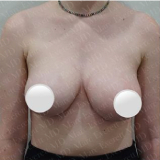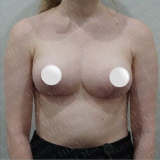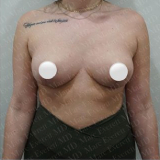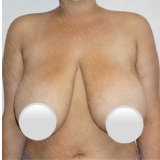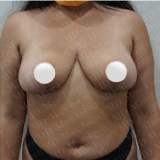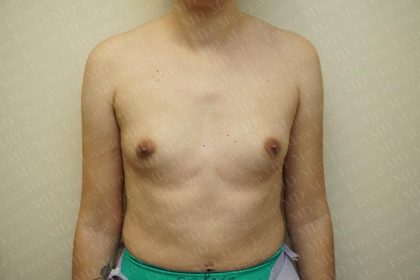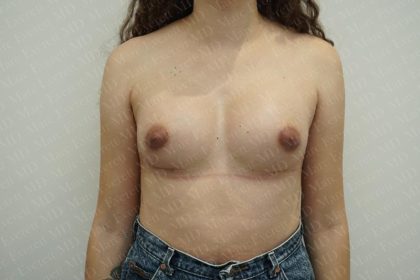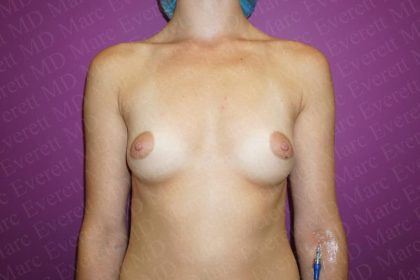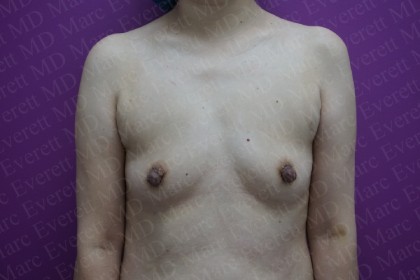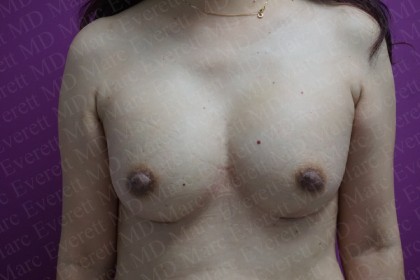Breast Asymmetry
Consultations offered at our two convenient locations in Manhattan, NY and Queens, NY

Breasts come in an infinite array of sizes and shapes, and often they do not come as a matching pair. Breast asymmetry describes breasts that display different volume, shape, elevation, firmness, nipple and areolar characteristics, or any combination of these. This is a natural phenomenon that affects most women to some degree. When the differences are significant, however, imbalanced breasts can be a source of self-consciousness and low self-esteem.
Contents
Before and After Photos
Every case of asymmetric breasts is different and every woman requires a customized surgical approach. Breast asymmetry correction in New York City begins with an in-depth consultation with Dr. Marc Everett. Dr. Everett will formulate a personalized treatment plan for breast asymmetry correction that is tailored to your unique anatomy and personal goals.
Procedure
Understanding Breast Asymmetry
Some breast asymmetry is normal. Most women’s breasts develop with small differences that are nothing to be concerned about. Breast characteristics can also fluctuate throughout a woman’s life. For example, asymmetry may be more noticeable during puberty, pregnancy or breastfeeding. These changes may be permanent or may return to normal once hormone levels stabilize.
Other possible contributors to breast asymmetry include traumatic injuries, conditions like breast hypoplasia or tuberous breast deformity, skeletal abnormalities, and in rare cases, breast cancer. Breast asymmetry can also come about due to an unsatisfactory breast augmentation. A candidate for breast asymmetry correction may possess one concern or multiple concerns simultaneously that lead her to consider surgery.
Reasons to Consider Breast Asymmetry Correction
Women can enjoy tremendous benefits when they have their breast asymmetry procedure performed by Dr. Everett, including:
- More pleasing and symmetrical shape to the breasts
- Improved confidence and self-image
- More balanced body proportions
- Easier time finding flattering clothing
- Renewed enjoyment of activities that once felt embarrassing
Considerations
If your breasts differ to a degree that makes you feel self-conscious, you are likely a candidate for surgical correction. A breast asymmetry surgery can provide you with substantial improvements in:
- Breast Volume
- Breast Position
- Nipple size
- Areola size
- Areola shape
- Nipple-areola complex position
- Overall body proportions
- Congenital breast abnormalities
- Clothing selection
- Unsatisfactory results from a prior breast surgery
Most ages are candidates, although breast development should be complete before surgery is considered. Ideal candidates for breast asymmetry correction are adults in good physical and emotional health, with reasonable expectations for improvement rather than perfection.
Procedure Details
The goal of breast asymmetry surgery is to achieve a more proportionate and attractive balance between a woman’s breasts. This can be accomplished in a variety of ways depending on the patient’s anatomy, goals and preferences.
Breast Augmentation
Breast augmentation enlarges breast size with the use of implants or fat grafting. Different implants can be used in each breast to create a more balanced shape or more even volume. In a fat transfer breast augmentation, different amounts of fat can be injected into each breast to achieve a similar effect without implants.
Breast Lift
A breast lift improves the position of the breasts on the chest wall, giving them a firmer feel and a more youthful perky and attractive shape. This improves symmetry if one breast sags lower than the other. A breast lift may be performed on its own or in conjunction with another breast surgery.
Breast Reduction
Breast reduction reduces breast size by removing excess skin and fat. This creates a more pleasing breast appearance and may also reduce discomfort in women who have excessively large breasts. Breast reduction can be performed on one breast only to make a larger breast more proportionate with a smaller breast.
Nipple and Areola Correction
Differences in nipple size or projection can be addressed with nipple reduction. Areolar asymmetry — differences in shape, size or position — can also be corrected.
Breast asymmetry procedures are highly customizable and can be easily tailored to the individual’s needs. Dr. Everett works closely with each patient to design a surgical plan that will produce the best aesthetic result for their circumstances.
Recovery & Results

Breast asymmetry correction takes place under general anesthesia. Dr. Everett will make incisions that allow him to perform the required corrections while minimizing postsurgical scarring. The incisions may be located on the breast, in the breast crease or around the areola, depending on which approach will provide the best result. After all necessary corrections have been made, he will close the incisions with sutures. The surgery itself may take anywhere from one to several hours to complete, depending on which procedures are necessary to achieve your desired outcome.
Recovery
Immediately after surgery, there will be some soreness, bruising and swelling in the surgical area. These are normal experiences and will diminish significantly during the first two weeks. Postoperative pain can be managed with medication. Patients should plan to rest as much as possible throughout their recovery, particularly during the first few days at home. Most women can return to their routines, including work, within a week or two with little evidence they underwent surgery. Full recovery for breast surgery is typically about six weeks.
Results
Some improvements will be visible right away. For example, if implants are used, the volume increase will be immediately apparent. Patients who have breast reduction will also notice size improvements right away. However, it may take six weeks or longer for the postoperative swelling to completely subside and the breasts to settle into their new position.
Under Dr. Everett’s skilled care, breast asymmetry correction improves the overall balance and symmetry of a woman’s breasts with beautiful, natural-looking results. You will be able to enjoy two proportionate breasts of similar volume, shape and position, giving you improved satisfaction and confidence every day. The procedure produces long-lasting, even permanent, results.
Contact
Breast asymmetry correction is a dramatic way to balance your body contour and give you curves you love. Dr. Marc Everett has honed his craft over years of schooling, fellowship training and private practice to bring women seeking breast surgery the outstanding results they deserve. Make an appointment with Dr. Everett by calling 212-774-7715 or sending a message online to discover which procedure or combination of procedures may help you meet your goals
FAQs
How do I know which type of breast surgery I need?
Planning your breast asymmetry surgery begins with an in-depth consultation with Dr. Everett. During this initial visit, Dr. Everett will conduct a thorough physical examination and medical history. He will also ask you to describe your goals and expectations. After a careful assessment of the specific nature of your concerns, he will collaborate with you to design a personalized surgical plan that suits your needs and desires.
Is breast asymmetry correction covered by insurance?
The short answer is “sometimes.” Breast asymmetry correction is usually considered cosmetic, which means most insurance plans will not cover it. There are limited scenarios in which it may be considered medical — for instance, if it is improving breast symmetry for women who have had breast reconstruction surgery. You must check with your insurance provider to see if they cover this procedure.
How visible will my scars be?
This depends partially on which surgical technique is used during your procedure. Some breast surgeries require more incisions than others. Scar appearance also depends on how well you care for the incision sites as they heal and on your body’s natural capacity for healing. Residual scarring will become increasingly inconspicuous over time. Most scars mature in six months to a year. In their final state, they will be thin, white or skin-toned lines.
I don’t have enough fat, can I use someone else’s?
Your body simply won’t accept someone else’s fat for transfer. After decades of research, there is now a solution to this problem. Tiger Aesthetics has now introduced AlloClae, a game changing product ready for use for patients who do not have enough of their own fat to undergo a fat augmentation or shape correcting procedure. AlloClae is a structural adipose filler made from processed, donated gifted cadaveric fat and it’s ready to use without having to undergo surgery to harvest fat. With a little bit of local anesthesia you can comfortably use this medically donated fat and fat matrix to immediate place volume and stimulate the growth of more over time!


